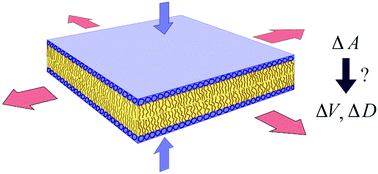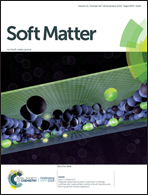Mechanical properties of lipid bilayers: a note on the Poisson ratio
Abstract
We investigate the Poisson ratio ν of fluid lipid bilayers, i.e., the question how area strains compare to the changes in membrane thickness (or, equivalently, volume) that accompany them. We first examine existing experimental results on the area- and volume compressibility of lipid membranes. Analyzing them within the framework of linear elasticity theory for homogeneous thin fluid sheets leads us to conclude that lipid membrane deformations are to a very good approximation volume-preserving, with a Poisson ratio that is likely about 3% smaller than the common soft matter limit  . These results are fully consistent with atomistic simulations of a DOPC membrane at varying amount of applied lateral stress, for which we instead deduce ν by directly comparing area- and volume strains. To assess the problematic assumption of transverse homogeneity, we also define a depth-resolved Poisson ratio ν(z) and determine it through a refined analysis of the same set of simulations. We find that throughout the membrane's thickness, ν(z) is close to the value derived assuming homogeneity, with only minor variations of borderline statistical significance.
. These results are fully consistent with atomistic simulations of a DOPC membrane at varying amount of applied lateral stress, for which we instead deduce ν by directly comparing area- and volume strains. To assess the problematic assumption of transverse homogeneity, we also define a depth-resolved Poisson ratio ν(z) and determine it through a refined analysis of the same set of simulations. We find that throughout the membrane's thickness, ν(z) is close to the value derived assuming homogeneity, with only minor variations of borderline statistical significance.



 Please wait while we load your content...
Please wait while we load your content...